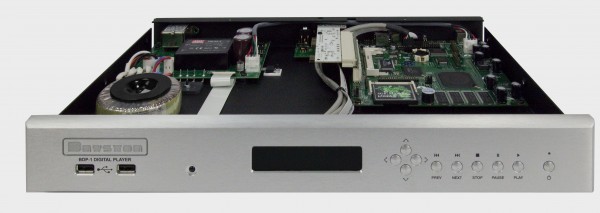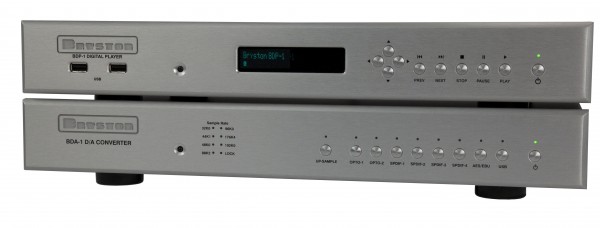Bryston BDP-1 Digital Player
Digital music has many paths into your home- silver discs, file downloads or live internet streaming. Deciding on the best option becomes a challenge due to the potential trade-off of sound quality for convenience. Bryston, a time-honored Canadian audio company, and no stranger to digital audio, offers a possible game changer: the Bryston Digital Player or BDP-1 which plays back audio files from USB sources like thumb drives or external hard drives. However, there are so many high quality digital transports and analog converters, one-box disc players, and digital music servers. So what is the BDP-1’s role in a high end audio system? Bryston’s answer to this question follows in this review.

Bits is bits or is they?
I have played lots of music stored on my PC through the USB port on my PerfectWave DAC. The architecture of this system usually imposes a sonic penalty, particularly on the files with higher sample rates (88.2kHz -192 kHz). Truth be told, many computer-based systems have crappy sound cards and will not pass files with resolutions above 96kHz/24-bit. USB digital streamers often have similar limitations. So how can you get the best bits into your sound system? One solution is elegant but sometimes pricey digital music servers that will play archived lossless files through a network or an internal hard drive. But suppose you prefer to store music on thumb drives or external hard drives which, unlike your computer’s hard drive, contains only music files. Enter the BDP-1.
A Cool Breeze Comes in from Canada
The BDP-1’s façade resembles a conventional digital disc player, minus the loading slot, and shares the cosmetics and excellent build quality of Bryston’s CDP-1 (digital disc player) and BDA-1 (digital analog converter). A very small green dot matrix display is flanked on the left by two USB ports and on the right by a bank of file folder navigation keys, a row of player function keys and a power button. The rear panel, from left to right, has an RS232 port, two more USB ports, an Ethernet port, a choice of SPDIF (BNC) or AES/EBU (XLR) outputs, remote power on/off trigger connections, and IEC Power inlet. An optional Bryston BR2 remote can control the player functions.

Putting on the BDP-1: one shoe at a time
The BDP-1 was very easy to install. I plugged in both the supplied Bryston thumb drive with its 8 high-resolution files and my 500 gigabyte hard drive containing high and standard resolution files. After connecting the BDP-1 to my PerfectWave DAC via its SPDIF and AES/EBU ports (for later comparisons), I added the power cord, and pressed the “ON” button. Reassuring messages illuminated the dot-matrix display, then the BDP-1 updated, recognized both USB devices, and, when I selected the thumb drive, it played music. A chapter straight out of the “audio made easy” book!
In addition to AIFF, FLAC and WAV lossless high resolution files, the BDP-1 handles numerous, ie, 50 other file types including AAC, MP3, MP4, WMA and OGG. While I had the Bryston BR2 remote control unit during this review, I also took full advantage of the BDP-1’s status as a Music Player Daemon (MPD). As an MPD, the BDP-1 search and play functions can be controlled through a home network using either PC programs (Bryston- MAXI player or Minion Player) or the free mPod app for iPad or iPhone. After a little help from James Tanner, Bryston’s VP for marketing, I got it all together and was, literally and figuratively, off to the races from my comfy couch.
The Sweet Sound of High-Resolution Music
As a senior citizen raised on the warm sounds of vinyl emanating from some really hot turntables, tone arms and cartridges, I have preferred this analog medium to the digital one offered by CDs, even when spun on some pretty high end players. That was then, this is now. The sound quality of the higher resolution SACDs diminished some of my earlier reservations about digital music files. But, alas, SACDs appear headed for gradual extinction as relatively few new titles or players are being issued. This trend makes the availability of high resolution music downloads even more important to the audio community.
For this review, I listened to the BDP-1, alternating SPDIF and AES/EBU connections. The differences, while not dramatic, favored the AES/EBU mode which sounded more natural and open. My first musical selections were 96kHz/24-bit material from the Bryston thumb drive. “Ain’t no Sunshine,” is a straightforward R&B duet between Christy Baron’s smoky voice and an upright bass. This recording’s palpable presence was simply stunning. The BDP-1/PerfectWave combo put these performers right there in my sound room. Rebecca Pidgeon’s “Spanish Harlem,” another Chesky favorite, has background percussion details in the rhythm section that sounded as clear as the proverbial bell. I raised the bar with some Reference Recordings’ 176.4/24-bit files on my external hard drive. Joel Fan’s “West of the Sun” is a knockout piano recital of power-charged keyboard pieces. Samuel Barber’s piano sonata was given its proper weight and its occasional percussive sound effects were quite startling in their immediacy. Ditto for Eiji Oue and Minnesota Orchestra’s performance of the Rachmaninoff “Symphonic Dances.” An immense wall of sound came rushing toward me much as it would in a live venue. Since I had the standard CDs of both recordings, I was able to do some A/B-ing of sources between the BDP-1 and the PerfectWave transport. No contest, the high-rez files were just so much better than their CD counterparts in recreating the sound stage elements of breadth, depth and, for want of a better term, coherence. To quote Etta James, at last, digitally sourced music that I could live with most happily.
As there are not tons of high-res files, I sampled some standard FLAC files of red book CDs, including Janos Starker’s superb account of Bach’s Cello Suites (RCA) and Neil Young’s “Live at Massey Hall 1971” (Reprise). Both recordings have vivid and realistic portrayals of solo instruments, probably as good as 44.1kHz/16-bit recordings will get on this system. Many more 96kHz/24-bit files followed; among the best being “Ella and Louis,” Fitzgerald and Armstrong at the top of their game (Verve), “Dawg’s Groove,” featuring legendary mandolinist David Grisman (Acoustic Disc), and Matthew Hall’s spectacular performance of the Bach “Goldberg Variations” (Linn). Eventually, and reluctantly, my listening concluded with the Jan Garabek/Hilliard Ensemble’s “Novum Officium” (ECM). This other-worldly program has Garabek’s mellifluous sax improvisations weaving in and out of the Hilliard’s splendid vocals. The BDP-1/PerfectWave DAC combo rendered these beautiful pieces in a natural, most analog-sounding way, with the performing space perfectly recreated.

The BDA-1 makes a cameo appearance.
The physical resemblance between Bryston’s DAC, the BDA-1, and the BDP-1 reflects their shared digital DNA. Since the virtues of the BDA-1 have been extolled in many previous reviews, I was curious to see how well these siblings actually got along. Within minutes of uniting them through the AES/EBU port, I received top-drawer audio performance in all respects. Re-listening to my high-res play list was an exercise in sheer musical enjoyment, with incredible retrieval of bass body and detail. Digitophiles, rejoice, this Bryston digital combination is a sonic marriage made in heaven and a potential blow struck for freedom from conventional disc players.
The BDP-1 ride ends: Look Ma, no discs!
When I met with James Tanner at this year’s International Consumer Electronic Show, I posed the obvious question: why make a device that can access music files yet requires an external DAC for playback? Tanner suggested the analogy of the separate component approach to building a sound system: each component performs only one task and, therefore, its design can be tailored for that purpose. Consider the BDP-1 as the new millennium’s CD transport minus the CDs. Because this player does not have to deal with additional onboard electronics like a disc drive or DAC, there is nothing to interfere with digital signal handling by its Linux operating system and its superb sound card. While the BDP-1 can perform its musical magic without the internet, its wired Ethernet connectivity allows remote operation via PCs or i-devices. I would regard this feature a necessity rather than an option since, at normal listening distances, the little green display is just not legible.
So here’s today’s pop quiz question: does this device belong in your system? If you play standard discs on a CD player, then you are listening to digital files as they were conceived 30 years ago. If you are entirely satisfied with technically, and often audibly, limited 44.1kHz/16-bit sound, turn in your exam paper, your quiz is over. But, if you have ventured into the world of high resolution music downloads, then you know exactly what Bryston had in mind with the BDP-1. With falling CD sales, and rising download purchases, digital music downloads will eventually become the only game in town. Oh, you say, you’ve been into the music download scene for some time. Bet you have a lot of those wonderful mp3 files, don’t you. If you intend to listen to digital downloads on a decent sound system, you will leave those lousy lossy mp3 files on your iPod and move up to the hi-res stuff. And when you make this inevitable ascent toward audio heaven, the BDP-1 will embrace you with open arms and bring along the celestial choir.
The Good
- Easy installation
- Excellent build quality
- Plays all types of standard and high-resolution music files
- Does not need a network for basic operation
- Remote control options through a networked PC or i-device
- USB-friendly
- Superb file handling
The Bad
- Screen is too small to read at normal listening distance
- Optional remote is limited to player functions
The Scorecard:
Design:
[Rating:4.5/5]
Performance:
[Rating:5/5]
Value:
[Rating:4/5]
Overall:
[Rating:4.5/5]
The Definitive Word
The Bryston BDP-1 is, to my knowledge, a unique and uncompromising conduit for opening up high resolution music files to listeners hungry for the best in digital audio. The multiple USB ports enable plug and play access of the large external drives essential for high resolution files (most album folders average 1 gigabyte) or customized play lists on dedicated thumb drives. Cut to the future. I can see an evening when your best friends gather around your BDP-1. They pull out their thumb drives and hard drives. They plug in, you push the button, the music starts, smiles all around, rock star high fives for you!
Specifications :
- Supported File Types: FLAC, WAV, AIFF, OGG, MP3, MPA4,AAC, WMA, and 50 others
- Output Sample rates:44.1kHz, 48 kHz, 88.2kHz, 96kHz, 176.4kHz, 192kHz
- Jitter: Master Clocks standard deviation less than 20 picoseconds 10Hz to 10 MHz
- Acoustic Noise: Silent
- Output impedance: BNC 75 Ohms, AES/EBU 110 Ohms.
- THD: N/A
- Channel Separation : N/A
- Dynamic Range: N/A
- Power Consumption: 10 watts
- Dimensions: W(17 or 19) x D-11 x H 2.75 inches
- Weight: 12 lbs (5.44kg)
More Information:
- Bryston Digital player (BDP-1) (SRP $2150 USD)
- www.bryston.com




